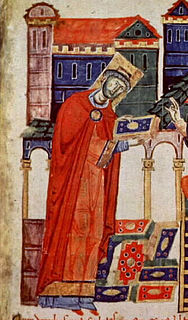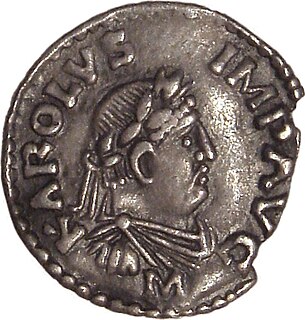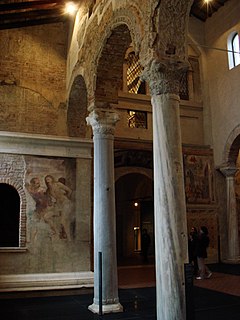
Desiderius Erasmus Roterodamus was a Dutch philosopher and Catholic theologian who is considered one of the greatest scholars of the northern Renaissance. As a Catholic priest, he was an important figure in classical scholarship who wrote in a pure Latin style. Among humanists he enjoyed the sobriquet "Prince of the Humanists", and has been called "the crowning glory of the Christian humanists". Using humanist techniques for working on texts, he prepared important new Latin and Greek editions of the New Testament, which raised questions that would be influential in the Protestant Reformation and Catholic Counter-Reformation. He also wrote On Free Will,In Praise of Folly, Handbook of a Christian Knight, On Civility in Children, Copia: Foundations of the Abundant Style, Julius Exclusus, and many other works.
Pope Adrian I was the bishop of Rome and ruler of the Papal States from 1 February 772 to his death. He was the son of Theodore, a Roman nobleman.
Pope Stephen III was the bishop of Rome and ruler of the Papal States from 7 August 768 to his death. Stephen was a Benedictine monk who worked in the Lateran Palace during the reign of Pope Zachary. In the midst of a tumultuous contest by rival factions to name a successor to Pope Paul I, Stephen was elected with the support of the Roman officials. He summoned the Lateran Council of 769, which sought to limit the influence of the nobles in papal elections. The Council also opposed iconoclasm.

Pope Victor III, was the head of the Catholic Church and ruler of the Papal States from 24 May 1086 to his death. He was the successor of Pope Gregory VII, yet his pontificate is far less notable than his time as Desiderius, the great abbot of Montecassino.
The 770s decade ran from January 1, 770, to December 31, 779.

The year 771 (DCCLXXI) was a common year starting on Tuesday of the Julian calendar. The denomination 771 for this year has been used since the early medieval period, when the Anno Domini calendar era became the prevalent method in Europe for naming years.
Pope Paul I was the bishop of Rome and ruler of the emerging Papal States from 29 May 757 to his death. He first served as a Roman deacon and was frequently employed by his brother, Pope Stephen II, in negotiations with the Lombard kings.

Carloman I, also Karlmann, was king of the Franks from 768 until his death in 771. He was the second surviving son of Pepin the Short and Bertrada of Laon and was a younger brother of Charlemagne. His death allowed Charlemagne to take all of Francia and begin his expansion into other kingdoms.

Desiderius, also known as Daufer or Dauferius, was king of the Lombards in northern Italy, ruling from 756 to 774. The Frankish king of renown, Charlemagne, married Desiderius's daughter and subsequently conquered his realm. Desiderius is remembered for this connection to Charlemagne and for being the last Lombard ruler to exercise regional kingship.

The siege or battle of Pavia was fought in 773–774 in northern Italy, near Ticinum, and resulted in the victory of the Franks under Charlemagne against the Lombards under King Desiderius.
Desiderius is a Latin given name, related to desiderium - which can be translated as "ardent desire" or "the longed-for". Various other forms include Desiderio in Italian, Desiderio or Desi in Spanish, Desidério in Portuguese, Didier in French and Dezső in Hungarian.
Saint Didier, also known as Desiderius, was a Merovingian-era royal official of aristocratic Gallo-Roman extraction.
Desiderata, was a Queen consort of the Franks. She was one of four daughters of Desiderius, King of the Lombards, and his wife Ansa, Queen of the Lombards. She was married to Charlemagne in 770, in order for him to create a bond between Francia and the Kingdom of the Lombards and attempt to isolate his brother Carloman I who ruled over the central territories of Francia. The marriage lasted just one year and there are no known children from the marriage.
The Patrimony of Saint Peter originally designated the landed possessions and revenues of various kinds that belonged to the apostolic Holy See i.e. the "Church of Saint Peter" in Rome, by virtue of the apostolic see status as founded by Saint Peter, according to Catholic tradition. Until the middle of the 8th century this consisted wholly of private property, but the term was later applied to the States of the Church, and more particularly to the Duchy of Rome.

Ansa or Ansia was a Queen of the Lombards by marriage to Desiderius (756–774), King of the Lombards.

The Beuron art school was founded by a confederation of Benedictine monks in Germany in the late 19th century.
Gerberga was the wife of Carloman I, King of the Franks, and sister-in-law of Charlemagne. Her flight to the Lombard kingdom of Desiderius following Carloman's death precipitated the last Franco-Lombard war, and the end of the independent kingdom of the Lombards in 774.

San Salvatore is a former monastery in Brescia, Lombardy, northern Italy, now turned into a museum. The monastic complex is famous for the diversity of its architecture which includes Roman remains and significant pre-Romanesque, Romanesque and Renaissance buildings.

Desiderius Hampel was a SS-Brigadeführer und Generalmajor der Waffen-SS during World War II who commanded the 13th Waffen Mountain Division of the SS Handschar and was possibly awarded the Knight's Cross of the Iron Cross (Ritterkreuz), the highest award in the military and paramilitary forces of Nazi Germany during World War II. After the war the Yugoslavian government asked for his extradition to charge him with war crimes, but he managed to escape from a British internment camp.

The 1086 papal election ended with the election of Desiderius, abbot of Monte Cassino as Pope Gregory VII's successor after a year-long period of sede vacante.










